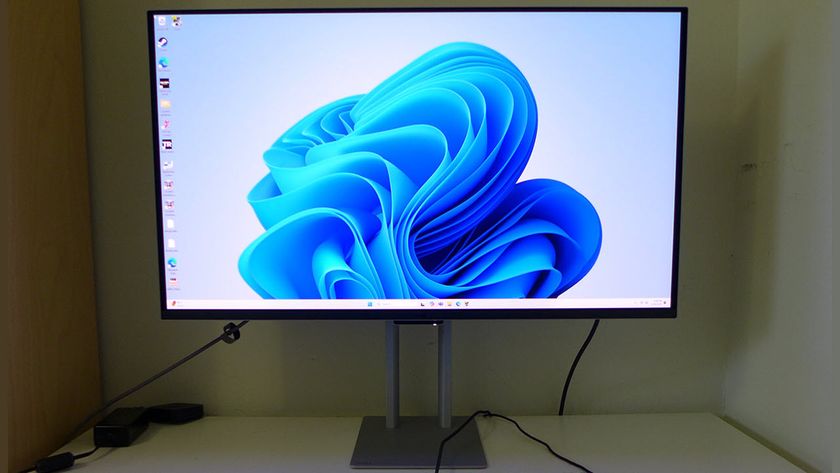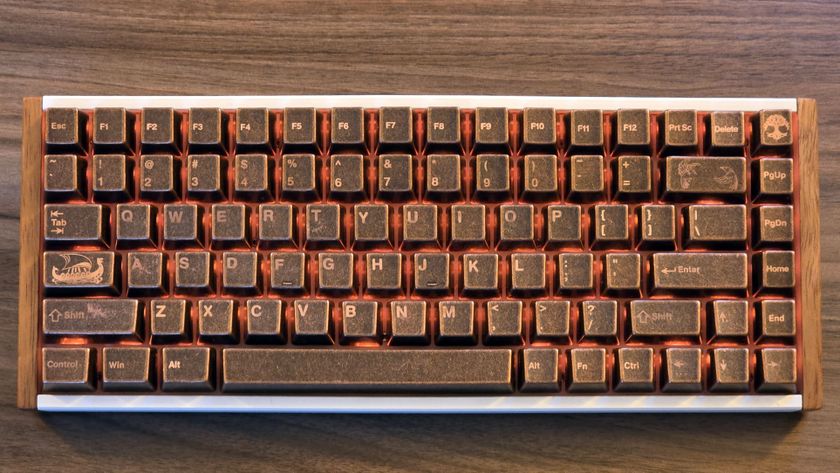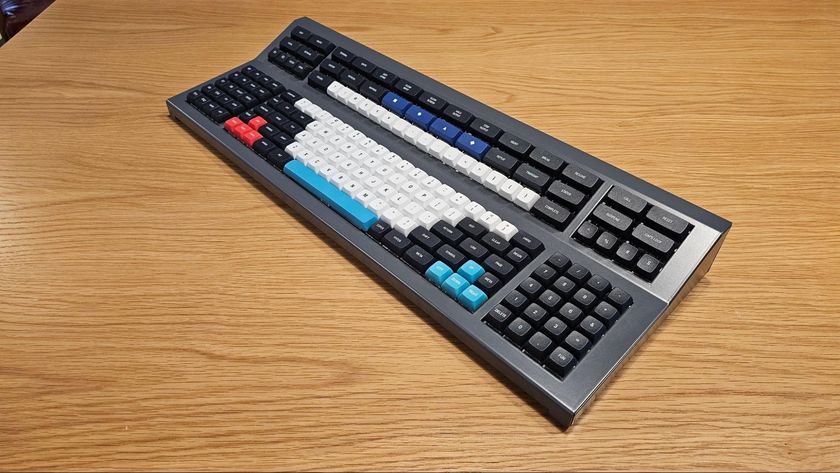Intel X58 Roundup: Six $300+ Platforms Compared
X58-T3eH8 BIOS, Software, And Accessories
Focusing on the most commonly-used BIOS settings reveals that DFI’s frequency ranges are far more realistic than many of its competitors. For example, Core i7 processors are well known to have a base clock limit of around 215 MHz, so the LANParty UT X58-T3eH8 offers a maximum setting of “only” 250 MHz.
| BIOS Frequency And Voltage Settings | |
|---|---|
| CPU Reference Clock | 133 to 250 MHz (1 MHz) |
| Clock Multiplier Adjustment | Yes |
| DRAM Ratios | DDR3-800 to DDR3-2133 (266 MHz) |
| PCIe Clock | 100 to 250 MHz (1 MHz) |
| CPU Vcore, Special Add | 1.06255 to 1.600 volts (0.00625 volts), |
| + 0.23% to + 114.88% (0.235%) | |
| CPU VTT (Uncore) Voltage | 1.21 to 1.61 volts (0.02 volts) |
| IOH (Northbridge) Vcore | 1.10 to 1.70 volts (0.020 volts) |
| ICH (Southbridge) Vcore | 1.05 to 1.35 volts (0.10 volts) |
| DRAM Voltage | 1.455 to 2.400 volts (0.015 volts) |
| CAS Latency Range | tCAS:3-11; tRCD: 3-10; tRP: 3-10; tRAS: 3-31 |
While the range for each setting appears reasonable, DFI still provides enough added control to confuse overclocking novices.






However, the learning curve isn’t as steep as some previous DFI motherboards, and settings such as reference voltage (VREF) that used to make DFI unique, are now found on many competing products. With that uniqueness gone, we still look forward to seeing how the X58-T3eH8 stacks up against those competitors.

DFI also allows user settings to be stored to several banks in BIOS, but the feature we found most useful was the “Load last bootable setting” option, which allows us to return to the previous “highest bootable speed” after trying a setting that wasn’t bootable.
DFI also includes an Auto Boost application for setting an overclock through Windows, but this is simply a Windows interface for stored BIOS values. Thus, it requires rebooting at each setting change. The software can also be used to install downloaded BIOS profiles, but the only one we found on the company’s site didn’t work properly with our RAM.
Accessories
| Accessories | |
|---|---|
| Documentation and Software | Motherboard Manual |
| VRM sink installation guide | |
| Motherboard Driver DVD | |
| Hardware | 1 x I/O Panel Shield |
| 1 x Thermal Paste Syringe | |
| 4 x Easy-Grip Jumpers | |
| 1 x Quick Connector Kit | |
| 1 x 3-way SLI Bridge | |
| 1 x Nvidia SLI Bridge | |
| 1 x CrossFire Bridge | |
| 1 x 80-conductor Ultra ATA Cable (Round) | |
| 1 x Floppy Cable (Round) | |
| 1 x Bernstein-R889 Audio Module | |
| 4 x SATA Cable | |
| 1 x Audio Module Cable | |
| 2 x 4-pin to 2-drive SATA Power Adapter |
DFI’s accessory focus appears to be SLI-centric, although the company does include a single CrossFire bridge.
Stay On the Cutting Edge: Get the Tom's Hardware Newsletter
Get Tom's Hardware's best news and in-depth reviews, straight to your inbox.

Notice that the CrossFire and standard (two-way) SLI bridges are spaced to use the top and bottom x16 slots, as the center slot is meant to hold a potential third card. By spacing two cards farther apart, DFI is able to optimize airflow for extra-hot four-GPU configurations such as a pair of HD 4870 X2 or GTX 295 graphics assemblies.
Current page: X58-T3eH8 BIOS, Software, And Accessories
Prev Page DFI LANParty UT X58-T3eH8 Next Page EVGA X58 3X SLI-
arkadi Some times it really hard to stay objective, but you did it, grate article.Reply
I would consider few other aspects as well, like service and RMA statistics.
In some countries you wont have official representation of a vendor, and in case of RMA you can end up with different MB model, usually not for the best.
From my experience i recommend for most of you to get more common boards. -
wdmso "Intel X58 Roundup: Six $300+ Platforms Compared " this title will leadReply
some less informed readers that they can get the cpu memory and MB for 300.00.
It should read "Intel X58 Roundup: Six $300+ Motherboards Compared"
the title is misleading -
neiroatopelcc I can't afford an i7 system, but when I see beautiful motherboards like that dfi and the foxconn board, I wish I could! That foxconn board almost makes me feel like looking at a beautifully built soltek board with uniform colors and good looks. Looks ain't everything, but looks do matter. I love my gigabyte board because it works great, but I would love it even more if it came 'styled' like the dfi green or the foxconn red board ....Reply -
When you review the less-expensive X58 boards, I'd appreciate it if you would evaluate them in terms of which is the likely to be the most stable, most reliable, and most problem-free non-overclocked board. Thanks.Reply
-
phantom93 Lol nice article, lol i love the soldering job on the port-80 diagnostics digits for the DFI lan party board.Reply -
inversed It seems odd to have skipped mentioning the Gigabyte EX58's driver-less RAID capability. I was able to get Windows XP to boot off of a mirrored RAID without needing the floppy and the initial setup went very quickly. One unfortunate aspect of this mobo, however is that it cannot output digital audio and analog audio at the same time. So no switching between surround sound and headphones without changing settings in the audio control software.Reply -
jeffunit Though the core i7 is a crazy fast processor, it doesn't offer ECC support. That is why I just bought an amd phenom II 940. Perhaps 'gamers' don't care about ECC but only how many graphics cards they can stuff in the mb. On the other hand, IBM estimated 1 error per gig per week. So at 4gb, that is less than 2 days between errors. Perhaps that isn't noticeable with microsoft operation systems, but I keep my machines up for weeks or months at a time...Reply
My cheap asus mb not only supports ECC, but ECC scrubbing, chipkill, and more. Who cares how fast a computer is, when it crashes often?
-
jeffunit Though the core i7 is a crazy fast processor, it doesn't offer ECC support. That is why I just bought an amd phenom II 940. Perhaps 'gamers' don't care about ECC but only how many graphics cards they can stuff in the mb. On the other hand, IBM estimated 1 error per gig per week. So at 4gb, that is less than 2 days between errors. Perhaps that isn't noticeable with microsoft operation systems, but I keep my machines up for weeks or months at a time...Reply
My cheap asus mb not only supports ECC, but ECC scrubbing, chipkill, and more. Who cares how fast a computer is, when it crashes often?
-
Crashman wdmso"Intel X58 Roundup: Six $300+ Platforms Compared " this title will lead some less informed readers that they can get the cpu memory and MB for 300.00.It should read "Intel X58 Roundup: Six $300+ Motherboards Compared"the title is misleadingReply
You're right: I belive the word "Platform" was substituted by another editor to make the title shorter, so it would fit better in the headline bar. I might have chosen "Mobos" myself when encountered with such an issue, but they don't like using slang in titles.
temporary87654When you review the less-expensive X58 boards, I'd appreciate it if you would evaluate them in terms of which is the likely to be the most stable, most reliable, and most problem-free non-overclocked board. Thanks.
Good suggestions, but the problem is that all these boards were stable and built for reliability when overclocked. Using lower speeds increases stability and reliability, and you just cannot exceed "100% Stability". All the boards also used high-quality electrical components, which means a reliability test would require years to reveal any differences.
inversedIt seems odd to have skipped mentioning the Gigabyte EX58's driver-less RAID capability. I was able to get Windows XP to boot off of a mirrored RAID without needing the floppy and the initial setup went very quickly. One unfortunate aspect of this mobo, however is that it cannot output digital audio and analog audio at the same time. So no switching between surround sound and headphones without changing settings in the audio control software.
We'll have to see what we can do about getting the author some digital speakers or a digital receiver headset to test for such issues in the future. That particular issue hadn't come up prior to testing. -
ryanaxiom What about the Gigabyte UD5? I guess it doesn't fall in the 300+ category at $288 from Newegg, but stil...Reply
It has all the benefits of the EX-58-Extreme minus the gigantic NB cooler, but also allows use of an x8 RAID card in the open ended slot (I have one installed) and if you get straight risers/wearout protectors you can install a x1 sound card in the top slot! The best of all worlds!!!
The only small complaint I have is that sometimes I have to try to boot twice since the AHCI bios doesn't always want to load after post.












